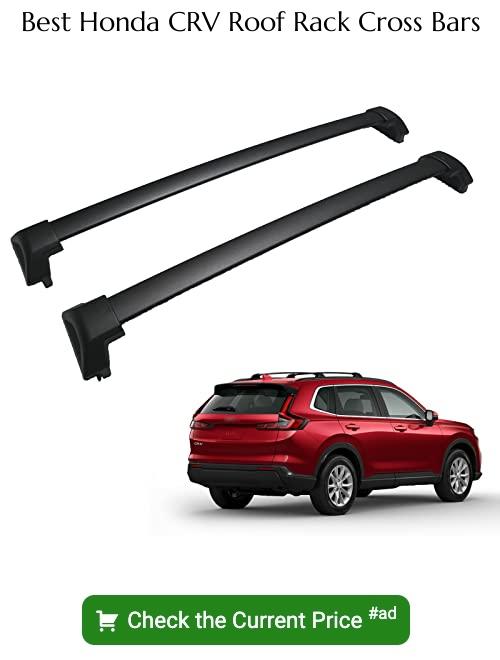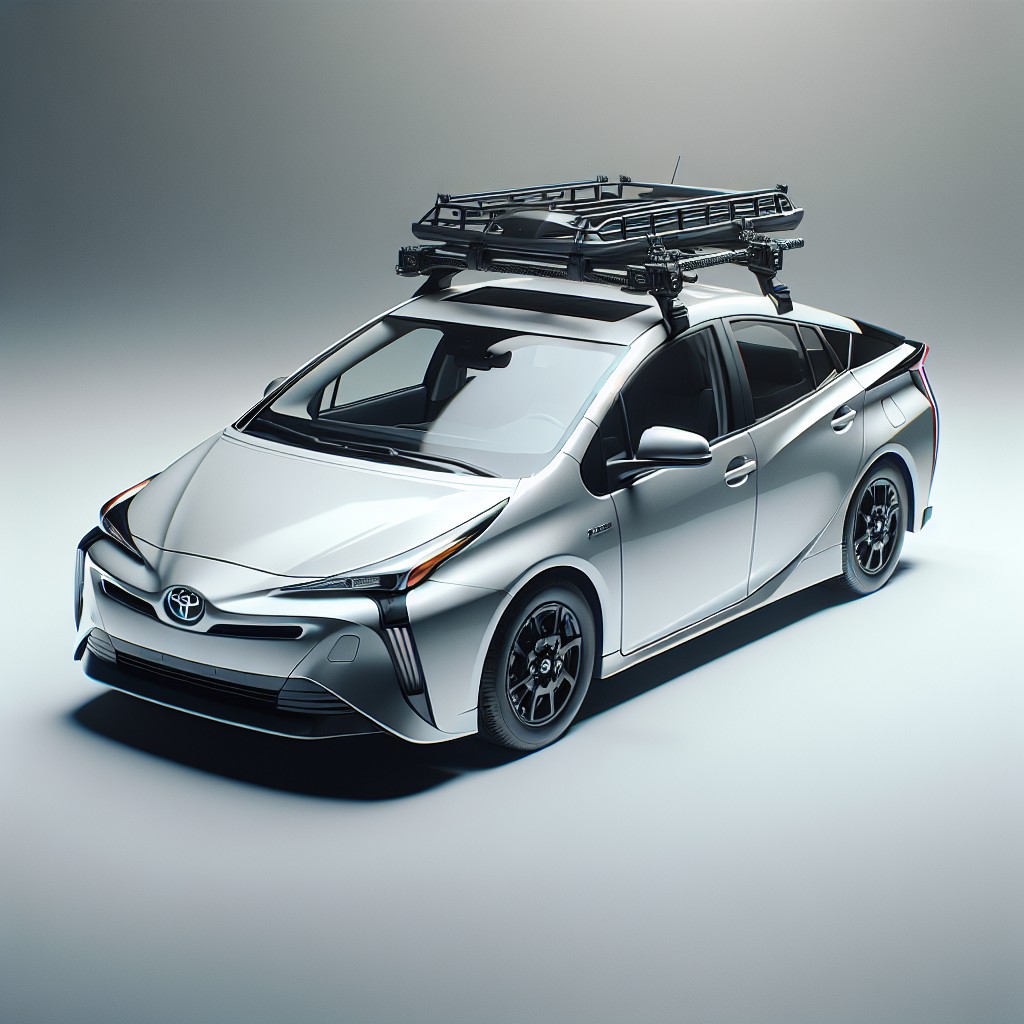Last updated on
Uncover the immense benefits of investing in a Honda CRV roof rack because it enhances storage capacity, boosts vehicle versatility, and provides an easier way to transport large items.
Key takeaways:
- Enhanced storage capacity for road trips and adventures.
- Versatility for transporting sporting equipment and gear.
- Safety and security for preventing distractions and accidents.
- Improved interior comfort by relocating excess baggage.
- Keeps the vehicle’s interior clean and free from dirt and mud.
Benefits of Installing a Roof Rack On Your Honda CR-V

Enhanced Storage Capacity: Adding a roof rack significantly increases your Honda CR-V’s cargo space, allowing for more luggage during road trips or adventures.
Versatility for Outdoor Activities: Roof racks provide the perfect solution to transport bulky sporting equipment such as kayaks, bikes, or skis, thereby supporting an active lifestyle.
Safety and Security: Securely mounting gear atop your vehicle reduces the likelihood of loose items causing distractions or accidents inside the cabin during travel.
Improved Interior Comfort: By relocating excess baggage to the roof, you ensure a more comfortable and spacious interior for passengers, which is particularly useful on long journeys.
Keeping the Vehicle’s Interior Clean: Transporting dirty or muddy equipment on the roof rack prevents soiling the vehicle’s interior, maintaining cleanliness and hygiene.
Roof racks are a straightforward enhancement that deliver practical benefits to any Honda CR-V owner seeking to expand the capability and utility of their vehicle.
Types of Roof Racks Available for the Honda CR-V

Honda CR-V owners can choose from several roof rack options to suit various needs and preferences:
1. Crossbars: Designed to run from one side of the vehicle to the other, they provide a stable base for attaching other carriers or boxes.
2. Side Rails: These generally come pre-installed on some CR-V models and allow for crossbars to be attached, creating a full rack system.
3. Cargo Boxes: Ideal for enclosed storage, these attach to the crossbars and come in a variety of sizes to accommodate different loads.
4. Bike Racks: There are specific designs for cyclists to easily transport bicycles atop their vehicle, minimizing interior space usage.
5. Kayak and Canoe Carriers: Featuring padded supports and secure tie-down points, they’re tailored to water sport enthusiasts transporting their vessels.
6. Ski and Snowboard Racks: These are perfect for winter sports lovers, as they securely hold snow gear and allow for more cabin room.
Owners should select a rack that aligns with their lifestyle, considering factors like load capacity, frequency of use, and type of gear they plan to transport. Compatibility with the CR-V model year is also crucial to ensure a proper fit.
OEM Vs Aftermarket Roof Racks for the Honda CR-V
When choosing between OEM (Original Equipment Manufacturer) and aftermarket roof racks for your Honda CR-V, consider the following:
OEM Roof Racks:
- Specifically designed by Honda to match your CR-V model
- Guaranteed compatibility and fit, ensuring a straightforward installation process
- Preserves vehicle warranty as they are manufacturer-approved accessories
- Typically higher in cost compared to aftermarket options
- May offer a seamless aesthetic that matches the vehicle’s design
Aftermarket Roof Racks:
- Produced by a variety of manufacturers with a range of styles and features
- Often more affordable than OEM options, providing a budget-friendly choice
- Can offer greater flexibility and customization to suit individual needs
- Installation may require more research to ensure proper fitment and compatibility
- It’s crucial to check quality standards to avoid damage to your vehicle
Whether prioritizing budget, aesthetics, or customizability, carefully assess which option aligns with your specific needs for your Honda CR-V.
Installation Process for Honda CR-V Roof Racks
Installing a roof rack on your Honda CR-V can be accomplished with relative ease by following these steps:
1. Read the Manual: Start with the manufacturer’s instructions to understand the specifics associated with your chosen roof rack system.
2. Assemble the Components: Lay out all parts and match them with the diagram provided in the manual. Pre-assemble loose components on the ground if necessary.
3. Clean the Roof: Before mounting, ensure the vehicle’s roof is clean to prevent scratches or damage.
4. Position the Towers: If your kit includes towers, place them at the prescribed points along the roof, making sure they align symmetrically on both sides.
5. Adjust Clamps or Fits: Roof racks either clamp onto the door frame or attach to pre-set fixture points. Adjust and secure them as per the guidelines.
6. Tighten and Secure: Use the tools provided or recommended to tighten all fixtures. Some systems have a torque indicator to signal when the fit is secure.
7. Check the Fit: After installation, gently pull on the rack to ensure it is firmly attached and there’s no movement.
8. Safety Inspection: Perform a final inspection to make sure all parts are well-connected and the rack is stable.
It’s crucial to adhere to the recommended weight limits and regularly check the rack for stability, especially before long trips. For those less mechanically inclined, professional installation is a viable option.
Weight Capacity and Limitations of CR-V Roof Racks
Understanding the weight capacity of a roof rack is crucial to ensure safety and prevent damage to your Honda CR-V. Each roof rack system has a specific weight limit, typically ranging from 75 to 165 pounds. This limit is determined by the strength of the rack itself and the roof’s structural capacity.
When considering load limitations:
- Refer to the Honda CR-V owner’s manual for the manufacturer’s recommended roof load limit.
- Distribute weight evenly across the rack to avoid stress on any one point of the roof.
- Take into account the weight of the rack itself when calculating the total weight of the cargo.
- For heavier items, ensure your CR-V’s suspension and tires can handle the additional load, especially when the vehicle is fully packed.
- Remember that off-road driving or dynamic weight (e.g., weight of cargo shifting during travel) can affect how weight impacts the vehicle structure and driving experience.
Adhering to these guidelines will help maintain your vehicle’s integrity and ensure a safe journey.
Maintenance Tips for Honda CR-V Roof Racks
Regular upkeep ensures the longevity of your roof rack, as well as the safety of your cargo and vehicle. Abide by these simple maintenance guidelines:
- Inspect regularly: Before and after use, check for any signs of wear or loose components. Tighten bolts and screws as needed to maintain structural integrity.
- Clean periodically: Wash the roof rack with mild soapy water, especially after exposure to salt or dirt, to prevent rust and corrosion.
- Lubricate moving parts: Hinges and locks benefit from a spray of lubricant to continue smooth operation and prevent seizing.
- Check for rust: Should you spot any rust, address it immediately with rust inhibitor or touch-up paint to stop the spread.
- Protect rubber components: Applying a rubber conditioner to seals and gaskets keeps them from drying out and cracking.
- Verify fit: Ensure that the rack is still correctly fitted to your CR-V and make adjustments if necessary to prevent wind noise or loss of items.
- Re-torque hardware: Follow the manufacturer’s guidance on re-torquing bolts, particularly after the initial installation and regular use.
By following these steps, your roof rack will remain reliable and ready for your next adventure.
Aerodynamics and Fuel Efficiency Considerations
Installing a roof rack can impact your Honda CR-V’s aerodynamics, which in turn affects fuel efficiency. A loaded rack increases the vehicle’s frontal area, leading to higher wind resistance. The following points should be taken into consideration to minimize these effects:
Slender Design: Select slimline or aerodynamic roof rack models that reduce drag.
Removable Racks: Consider installing a removable rack that can be detached when not in use, thereby restoring your vehicle to its original aerodynamic profile.
Cargo Placement: Position heavier items at the center of the rack to maintain balance and reduce wind resistance.
Roof Box Options: If carrying luggage, enclosed roof boxes with a streamlined shape can help decrease drag compared to open baskets or loosely tied gear.
Speed Factors: Higher speeds amplify the effect of drag on fuel consumption, so driving at moderate speeds can mitigate some of the efficiency losses.
Regular Inspections: Check your roof rack’s fittings regularly as loose components can create additional drag.
By attentively managing these aspects, you can help lessen the impact of a roof rack on your Honda CR-V’s aerodynamics and maintain better fuel economy.
Noise Considerations With CR-V Roof Racks
Adding a roof rack to your Honda CR-V can alter the vehicle’s aerodynamics, potentially leading to increased wind noise at higher speeds. This can be particularly noticeable on highways or during windy conditions.
Here are some points to help minimize noise:
- Profile Selection: Choose a roof rack with a low profile and aerodynamic design to reduce wind resistance.
- Accessory Positioning: Place accessories and cargo toward the center of the roof rack to minimize drag.
- Padding: Use rubber or foam padding to cushion between the rack and cargo to dampen vibration and noise.
- Wind Fairings: Install a wind fairing at the front of the rack. It redirects airflow over the rack, decreasing noise.
- Regular Checks: Ensure all components are tightly secured, as loose parts can vibrate and create additional sound.
- Loading Technique: Distribute weight evenly and securely strap down items to prevent them from moving and generating noise.
By considering these factors, you can enjoy the added utility of a roof rack on your Honda CR-V without significant noise disruption.
Accessories and Add-Ons for Honda CR-V Roof Racks
Maximizing the utility of your Honda CR-V’s roof rack can be easily achieved with a range of accessories and add-ons:
- 1. Cargo Boxes: For weatherproof and secure storage, cargo boxes come in various sizes to accommodate your gear without sacrificing interior space.
- 2. Bike Racks: Easily transport bicycles without compromising your vehicle’s rear access, these racks ensure your bikes arrive safely.
- 3. Kayak Carriers: Designed with padded arms or rollers, these carriers facilitate easy loading and unloading of kayaks and similar watercraft.
- 4. Ski and Snowboard Racks: Lockable and easy to use, they provide a safe way to carry your winter sports equipment to the slopes.
- 5. Roof Bags: A versatile and foldable option for extra storage, roof bags are ideal for those seeking a lightweight and flexible solution.
- 6. Roof Basket: For bulkier items that don’t require protection from the elements, a roof basket offers an open storage area that is easily accessible.
- 7. Lighting Brackets: Enhance visibility for off-road adventures with brackets that allow for the mounting of additional lights.
Each accessory should be selected based on the specific needs of your activities, ensuring versatility and functionality while on the go. It’s important to check compatibility with your existing roof rack system to ensure a proper fit and to maintain safety.
Cost Analysis: Investing in a Honda CR-V Roof Rack
The initial expenditure for a roof rack is influenced by several factors including brand, materials, and load capacity. OEM options, while typically more expensive, often ensure a tailor-made fit and aesthetic cohesion with the Honda CR-V. Aftermarket alternatives can provide more versatility in price and design, often offering a broader range of features.
Installation costs, if not self-installed, add to the overall investment. However, considering a DIY approach can be a cost-saving opportunity. When assessing long-term value, durability of materials comes into play. Aluminum racks, for example, resist rust and corrosion better than steel, potentially saving on replacement costs.
Additional accessories to secure cargo or specific sports equipment may also affect the total cost. It is advisable to anticipate these needs to avoid incremental spending over time.
Weight capacity plays a pivotal role in value. Investing in a roof rack with a higher load limit than currently needed may seem unnecessary initially but allows for versatility to accommodate future demands without needing an upgrade.
Fuel efficiency impact is marginal but worth considering. A well-designed rack minimizes drag and thus, fuel consumption over time, contributing to overall savings.
While upfront costs may seem daunting, evaluating the long-term benefits against these factors facilitates a well-informed decision, positioning the investment in a Honda CR-V roof rack as not only a practical addition to your vehicle but also a financially sound decision.
FAQ
Can you put roof racks on a Honda CR-V?
Yes, roof racks can be installed on a Honda CR-V and securely haul 165lbs of cargo.
Can you put a Thule on a Honda CR-V?
Yes, a Thule can be installed on a Honda CR-V, specifically with the use of Thule Evo Clamp and Thule Edge Clamp foot packs, which are designed for vehicles without pre-existing roof rack attachment points or factory-installed racks.
How much can a Honda CR-V roof hold?
The roof of a Honda CR-V can support a maximum load of 75Kg.
Does 2023 Honda CRV come with roof rails?
Yes, the 2023 Honda CRV does come equipped with roof rails.
What are the best roof rack options for a Honda CR-V?
The best roof rack options for a Honda CR-V include the Thule WingBar Evo Load Bars, the Rhino-Rack Vortex Aero Crossbars, and the Yakima JetStream Crossbars.
How do you install a roof rack on a Honda CR-V?
To install a roof rack on a Honda CR-V, follow the manufacturer’s instructions provided, typically involving positioning the rack on the car roof, threading through the mounting hardware, tightening all bolts securely, and double checking for stability.
Is it safe to drive at high speeds with a loaded roof rack on a Honda CR-V?
Driving at high speeds with a loaded roof rack on a Honda CR-V is not recommended due to potential instability and increased wind resistance.





